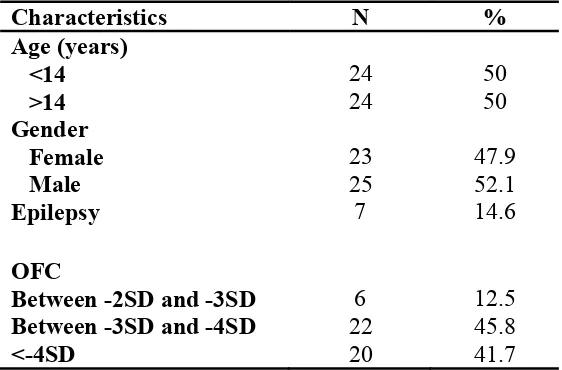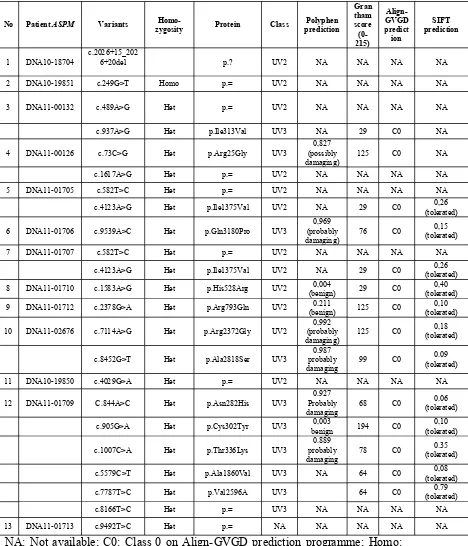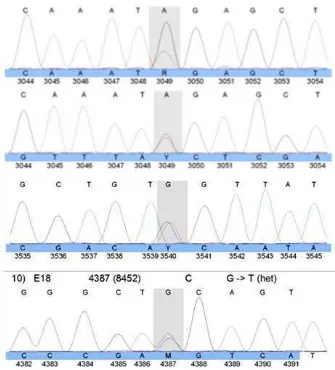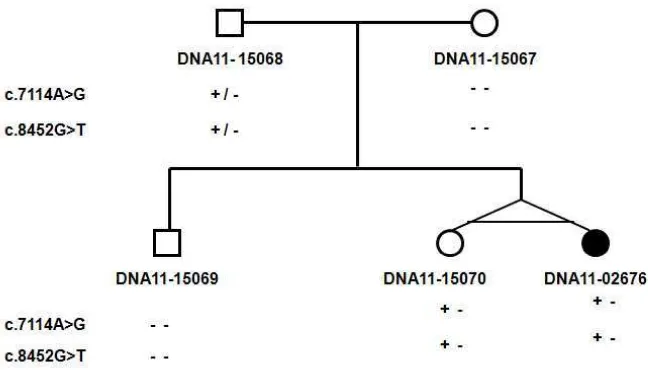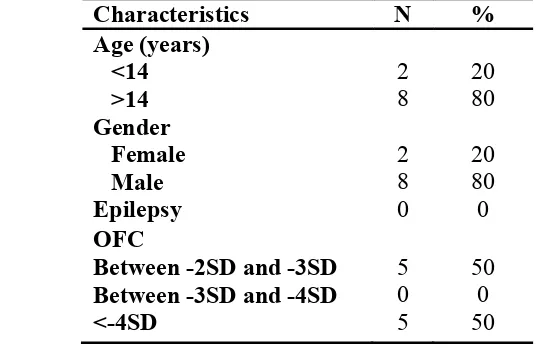47
CHAPTER IV
RESULTS
4.1. Microcephaly
4.1.1. General description
This study found that from a previous study of 527 individuals with MR, 48 (23 female and 25 male) unrelated individuals were identified as being microcephalic with a head circumference ranging from -2 to -4 SD, which counted for 9.1% of all the collected MR individuals. The ages of all the individuals were between 7 and 32 years.
Below are the demographic data of the mentally retarded individuals with microcephaly (Table 10).
Table 10. Demographic data of mentally retarded individuals with microcephaly
DNA sequencing was performed on all 48 samples of the MR individuals with microcephaly. Analysis for ASPM gene mutations was performed, followed by analysis of WDR62 gene. Only those patients with head circumference less than -4SD underwent sequencing of MCPH1, CDK5RAP2, CENPJ and STIL gene.
4.1.2. ASPM
Sequencing was performed on 48 samples for ASPM gene. After PCR amplification and DNA purification, the amplicons were sequenced using 42 sets of PCR primers. Sequences were compared with the reference genomic and cDNA sequences (NM_018136.4).
49
Table 11. Study subjects with genetic variants of ASPM gene
No Patient ASPM Variants zygosity Homo- Protein Class prediction Polyphen Gran
6 DNA11-01706 c.9539A>C Het p.Gln3180Pro UV3
0,969
10 DNA11-02676 c.7114A>G Het p.Arg2372Gly UV2
0,992 (probably damaging)
125 C0 0,18
(tolerated)
c.8452G>T Het p.Ala2818Ser UV3
0.987
12 DNA11-01709 C.844A>C Het p.Asn282His UV3
0.927
c.1007C>A Het p.Thr336Lys UV3
respectively (Figure 10). Based on this finding, follow up was done and samples were requested from the parents and at least available two siblings. The samples from the family (father, mother, brother, twin sister) were sequenced and analysed for the presence of the unknown variants (Figure 10).
51
Polyphen-2 protein prediction for the 2 variants of subject DNA11-02676 with high scores and are shown (Figure 11, Figure 12).
Figure 11. Polyphen-2 result for variant c.7114A>G of subject DNA11-02676.
Polyphen-2 scores at 0.992, predicted as probably damaging.
Figure 12. Polyphen-2 result for variant c.8452G>T of subject DNA11-02676.
Polyphen-2 scores at 0.987, predicted as probably damaging.
Figure 13 shows the pedigree of of subject DNA11-02676 after follow up DNA collection of 2 parents and 2 siblings.
The results from the family (Figure 13) showed that both variants were identified in the father and none in the mother, indicating that the 2 variants originated from the same allele in the father. As MCPH is an autosomal recessive disease, it is not likely that these variants were the pathogenic cause since the father was unaffected.
As the twin sister also had the exact 2 variants, there was still a possibility that there was a second hidden mutation from the maternal allele which caused the pathology in subject DNA11-02676 but not the twin sister. Identifiler test was subsequently performed to determine the zygosity status of the twins with the result that the twins were monozygotic (identical common variants were found in 15 marked locations indicating identical DNA sequence). The twin sister did not have any dysmorphic feature or mental retardation. This monozygosity status further strengthen the argument that autosomal recessive inheritance for the mental retardation and microcephaly in this family was unlikely.
4.1.3. WDR62
WDR62 gene sequencing and analysis was performed on 48 samples, using a set of 27 PCR primer pairs. Sequences were then compared with the genomic reference (NM_001083961.1). As with ASPM, only UV2 (unlikely to be pathogenic) or UV3 (likely to be pathogenic) results were further analyzed using protein prediction programs while UV1 (certainly non-pathogenic) variants were not included in this list (Table 12).
Table 12. Study subjects with genetic variants of WDR62 gene
No Patient WDR62
Variants Homo-zygosity
53
4.1.4. MCPH1, CDK5RAP2, STIL and CENPJ
MCPH1, CDK5RAP2, STIL and CENPJ gene analysis were performed. There were no UV2, UV3, UV4 variants found on these 4 genes and only UV1 single nucleotide polymorphisms (SNP) were found on these genes (Table 13). A list of all SNP found on the MCPH genes are available (Appendix IV), together with frequency comparisons with the European population. As SNP frequency data from the Indonesian population is still rare, a list of SNP in the Indonesian population may assist in future genome-wide association studies.
Table 13. List of MCPH1, CDK5RAP2, CENPJ and STIL variants found
4.2. Macrocephaly 4.2.1. General finding
Below are the overview of characteristics (Table 14) of the mentally retarded individuals with macrocephaly. There were no unknown variants or SNP found in DNA sequencing and analysis of the PTEN gene in the 10 individuals of 527 mentally retarded individuals (1.9 %).
Table 14. Demographic data of mentally retarded individuals with macrocephaly
Characteristics N %
